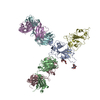+Search query
-Structure paper
| Title | Patient-derived monoclonal antibody neutralizes SARS-CoV-2 Omicron variants and confers full protection in monkeys. |
|---|---|
| Journal, issue, pages | Nat Microbiol, Vol. 7, Issue 9, Page 1376-1389, Year 2022 |
| Publish date | Jul 25, 2022 |
 Authors Authors | Craig Fenwick / Priscilla Turelli / Dongchun Ni / Laurent Perez / Kelvin Lau / Cécile Herate / Romain Marlin / Erica Lana / Céline Pellaton / Charlène Raclot / Line Esteves-Leuenberger / Jérémy Campos / Alex Farina / Flurin Fiscalini / Nathalie Dereuddre-Bosquet / Francis Relouzat / Rana Abdelnabi / Caroline S Foo / Johan Neyts / Pieter Leyssen / Yves Lévy / Florence Pojer / Henning Stahlberg / Roger LeGrand / Didier Trono / Giuseppe Pantaleo /    |
| PubMed Abstract | The SARS-CoV-2 Omicron variant has very high levels of transmission, is resistant to neutralization by authorized therapeutic human monoclonal antibodies (mAb) and is less sensitive to vaccine- ...The SARS-CoV-2 Omicron variant has very high levels of transmission, is resistant to neutralization by authorized therapeutic human monoclonal antibodies (mAb) and is less sensitive to vaccine-mediated immunity. To provide additional therapies against Omicron, we isolated a mAb named P2G3 from a previously infected vaccinated donor and showed that it has picomolar-range neutralizing activity against Omicron BA.1, BA.1.1, BA.2 and all other variants tested. We solved the structure of P2G3 Fab in complex with the Omicron spike using cryo-electron microscopy at 3.04 Å resolution to identify the P2G3 epitope as a Class 3 mAb that is different from mAb-binding spike epitopes reported previously. Using a SARS-CoV-2 Omicron monkey challenge model, we show that P2G3 alone, or in combination with P5C3 (a broadly active Class 1 mAb previously identified), confers complete prophylactic or therapeutic protection. Although we could select for SARS-CoV-2 mutants escaping neutralization by P2G3 or by P5C3 in vitro, they had low infectivity and 'escape' mutations are extremely rare in public sequence databases. We conclude that this combination of mAbs has potential as an anti-Omicron drug. |
 External links External links |  Nat Microbiol / Nat Microbiol /  PubMed:35879526 / PubMed:35879526 /  PubMed Central PubMed Central |
| Methods | EM (single particle) |
| Resolution | 3.04 - 4.01 Å |
| Structure data | EMDB-14141, PDB-7qti: EMDB-14142, PDB-7qtj: EMDB-14143, PDB-7qtk: |
| Chemicals |  ChemComp-NAG: |
| Source |
|
 Keywords Keywords |  VIRAL PROTEIN / SARS-CoV-2 S Omicron Spike B.1.1.529 VIRAL PROTEIN / SARS-CoV-2 S Omicron Spike B.1.1.529 |
 Movie
Movie Controller
Controller Structure viewers
Structure viewers About Yorodumi Papers
About Yorodumi Papers











